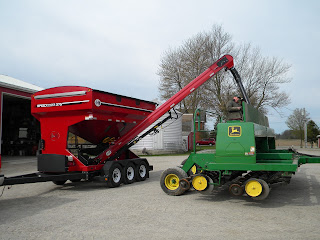I had some fun at Dave Phillips' expense a few posts back, but Dave was bang on when he said winter was still going to linger. Cathy's flowers don't look so good anymore.
Recently we have seen why planting corn in March is a dumb idea. The last day where the daytime temperature peaked at 18 degrees was two weeks ago. The heat accumulation since then has been a grand total of 16 heat units. This is normal and very close to what we would expect for late March through early April. To put it in perspective, 150 heat units are required to get corn to emerge.
One question asked several times this week is whether Pioneer has an early planting date where re-plant seed would not be honoured if you plant before that date. The answer is no. There is no re-plant cut off date for early planting. Crop insurance does not have one either. Personally, I would support the idea because there is no data to suggest we can plant corn in March without significant risk. On the other hand, despite coffee shop rumours, there is a very small amount of corn actually planted. If Pioneer did have a cut off date it would have no effect on the ultra aggressive types trying to prove everyone else wrong. They would charge on regardless and stomp their feet if it did not work out.
It looks like the cold temperatures are going to linger. As April moves along the temptation to start planting becomes larger. What do we need to consider to give us the best chance of success?
The first, second and last thing is temperature. Avoid planting just prior to a cold weather event. The potential risk of chilling injury looks like this.
Imbibitional chilling can occur if the water temperature entering the seed is below 10 degrees. Daytime highs need to get back to consistent 12-15 degrees before we should consider going very far with a corn planter. Forecast models are indicating that we may get this trend toward the end of next week. The balance of April, if temperature forecasts are accurate, is still trending cold which is NORMAL.
It may be wise to apply 28% N and soil herbicides, like Primextra and Integrity. It gets one job done. The cool soils will keep the bacteria from breaking down either the nitrogen or herbicide. These herbicides have a 30 day prior to plant registration on the label.
The same thinking applies to burndowns. Fall annuals and volunteer wheat are growing because they don't mind the cold. As they get bigger rates need to go higher and they become tougher to control.
In the meantime, keep a positive attitude and use your time wisely.
Have a Happy Easter.
P.S. Some good tips are found in the minutes from the agribusiness breakfast meeting.
http://fieldcropnews.com/2012/04/exeter-agribusiness-breakfast-minutes-april-3-2012/
















.JPG)



.JPG)
.JPG)